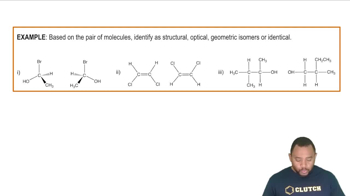Determine the relationship between each of the pairs of the following compounds. Are they structural isomers (different molecules), conformational isomers (the same molecule), or not related?
(b) <IMAGE> and <IMAGE>
 Verified step by step guidance
Verified step by step guidance



Determine the relationship between each of the pairs of the following compounds. Are they structural isomers (different molecules), conformational isomers (the same molecule), or not related?
(b) <IMAGE> and <IMAGE>
Determine the relationship between each of the pairs of the following compounds. Are they structural isomers (different molecules), conformational isomers (the same molecule), or not related?
(a) <IMAGE> and <IMAGE>
Determine the relationship between each of the pairs of the following compounds. Are they structural isomers (different molecules), conformational isomers (the same molecule), or not related?
(d) <IMAGE> and <IMAGE>
Mark the chiral centers in the following molecules, if any, with an asterisk (*):
(a) <IMAGE>
Mark the chiral centers in the following molecules, if any, with an asterisk (*):
(d) <IMAGE>
Ritalin®
ALLIED Health Mark the chiral centers in the following molecules, if any, with an asterisk (*):
(b) <IMAGE>
Pantothenic Acid, a B vitamin